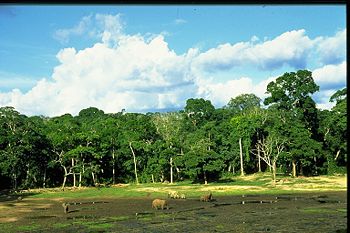Duiker
A Duiker is any of 16 small to medium-sized antelope species from the Bovidae family. They are native to Sub-Saharan Africa.
Local names include Gidi-gidi, Gri-gri (Krio), Kaikulowuli, Kaikulowulei (Mende tribal name meaning "squirrel duiker"), Dikidiki (Creole), and Nienagbé (from Côte d'Ivoire).[1] Duiker comes from the Afrikaans word "diver". When frightened they will leap into the forest's safety.
Physical Characteristics
All have the same distinctive body type with an arched back and pointed face. Although the different species vary in size from the largest Yellow-backed duiker (weighing up to 175lbs) to the tiny Royal Antelope (weighing just 1.5kg/3.3lbs). Full adult coloration is approximately obtained at one year of age. The species are put into two groups, bush and forest. Bush females are larger than the males, they usually are hornless. Male and female forest duikers are about the same size and both have horns. The extent of there horns are small and spike like, lying flat against the head, not useful for fighting.[2] The hind legs are longer than the front legs allowing quick springs to penetrate thickets.
Habitat
Found in thick brush and forest over most of Africa. The blue duikers are found in W and central Africa. The gray, or common, duiker, (Sylvicapra grimmia) is found from Ethiopia to the Cape of Good Hope and W to Senegal.
Diet
The duiker has a varied feeding habits. Most of their diet consists of foliage from bushes and trees. There small size limits the reach of food sources. Berries and fruit that have fallen naturally (or picked and dropped by other animals) are essential in every day diet. This leads to behavior of actively following beneath canopy foragers, where they compete with bush pigs and porcupines. Figs are a high percentage of the diet. They have a large mouth that allows them to feed on sizable fruits, mushrooms and other bulky items. Sometimes under circumstances duikers may eat insects, small vertebrates, and birds. In Tanzania, a picture was taken of an Abbot's Duiker with a large frog in its mouth (BBC Wildlife 22:10). These creatures are an omnivore, meaning an animal that feeds on both animal and plant substances. This broad based subsistence means duikers are not specifically adapted to only eat and digest either meat or plant material.
Conservation and Threats
Crowned Eagles and Leopards are among the most significant predators of duikers. All duikers freeze and crouch to escape detection, if diving into the bush is not an option. Natural enemies are the lion, cheetah, hunting dog, hyena, jackal, python, baboon, and crocodile.
Species
Africa's various antelope are classified into over 70 species. These are divided into nine tribes, of which the Cephalophini is the largest, with 16 species.
Taxonomy
Kingdom:Animalia
Phylum:Chordata
Class:Mammalia
Order:Artiodactyla
Family: Bovidae
Subfamily: Cephalophinae
Genera: Cephalophus, Sylvicapra
- Subfamily Cephalophinae
- Genus Cephalophus
- Abbott's Duiker, Cephalophus spadix
- Ader's Duiker, Cephalophus adersi
- Bay Duiker, Cephalophus dorsalis
- Black Duiker, Cephalophus niger
- Black-fronted Duiker, Cephalophus nigrifrons
- Blue Duiker, Cephalophus monticola
- Harvey's Duiker, Cephalophus harveyi
- Jentink's Duiker, Cephalophus jentinki
- Maxwell's Duiker, Cephalophus maxwellii
- Ogilby's Duiker, Cephalophus ogilbyi
- Peters's Duiker, Cephalophus callipygus
- Red-flanked Duiker, Cephalophus rufilatus
- Red Forest Duiker, Cephalophus natalensis
- Ruwenzori Duiker, Cephalophus rubidis
- Weyns's Duiker, Cephalophus weynsi
- White-bellied Duiker, Cephalophus leucogaster
- Yellow-backed Duiker, Cephalophus sylvicultor
- Zebra Duiker, Cephalophus zebra
- Genus Sylvicapra
- Common Duiker, Sylvicapra grimmia
- Genus Cephalophus
Links
<a href="http://www.animalorphanagekenya.org" target="_top">Mount Kenya Wildlife Conservancy - the animal orphanage</a>

